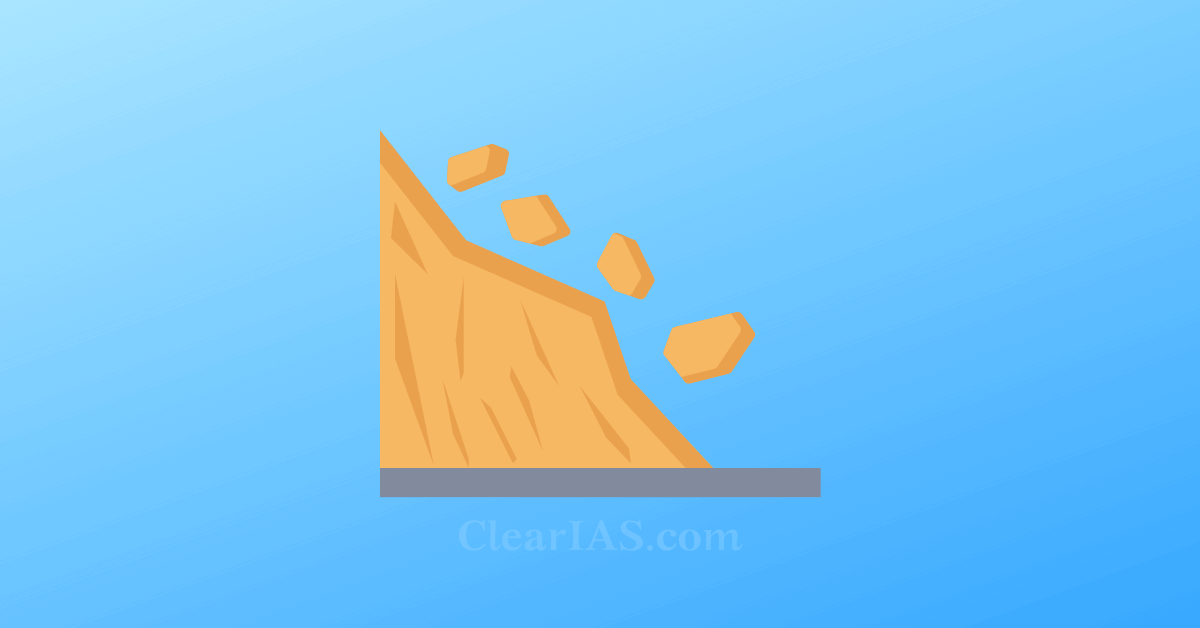
We have been discussing geomorphic processes in our previous notes in the Geography section.
We have already seen that geomorphic processes are classified into endogenic processes and exogenic processes.
As endogenic processes are already covered in detail, in this post we focus on exogenic forces and exogenic processes.
What are Exogenic Forces?
The forces which derive their strength from the earth’s exterior or originate within the earth’s atmosphere are called as exogenic forces or external forces.
The action of exogenic forces results in wearing down and hence they are considered as land wearing forces.
Exogenic Processes or Denudation
The processes which occur on the earth’s surface due to the influence of exogenic forces are called exogenic processes or exogenic geomorphic processes.
Weathering, mass wasting, erosion, and deposition are the main exogenic processes.
All the exogenic processes are covered under a general term- denudation, which means strip off or uncovers.
The elements of nature capable of doing these exogenic processes are termed geomorphic agents (or exogenic geomorphic agents). E.g. the wind, water, waves etc.
Note: A process is a force applied on earth materials affecting the same. An agent is a mobile medium (like running water, moving ice, winds, waves etc) which removes, transport and deposits earth materials.
Geomorphic processes and geomorphic agents especially exogenic, unless stated separately, are one and the same.
Gravity and gradients are the two things that make these agents mobile.
All the movements either within the earth or on the surface of the earth occur due to gradients– from higher levels to lower levels, from high pressure to low pressure etc.
The exogenic forces derive their energy from the atmosphere determined by the ultimate energy from the sun and also the gradient created by tectonic factors. We have already discussed in previous articles that slopes on the earth surface are mainly created by tectonic factors or earth movements due to endogenic forces.
We know that force applied per unit area is called stress. Stress is produced in a solid by pushing or pulling.
The gravitational force acts upon all earth materials having a sloping surface and tends to produce movement of matter in the down-slope direction. This creates stress and induces deformation to the particles.
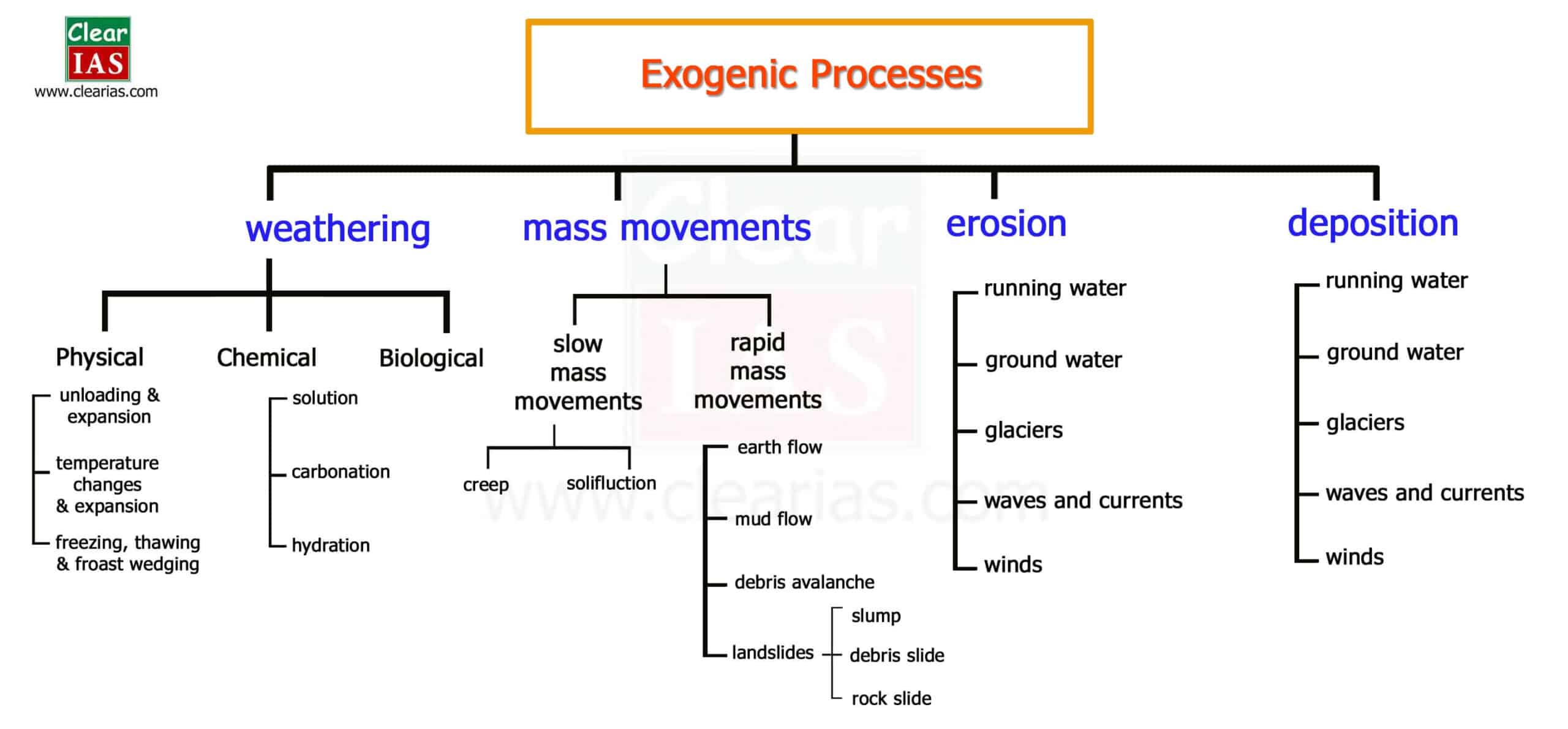
Weathering
Weathering is the action of elements of weather and climate over earth material.
It can be defined as mechanical disintegration and chemical decomposition of rocks through the actions of various elements of weather and climate.
When rocks undergo weathering, some minerals are removed through chemical/ physical leaching by groundwater and thereby the concentration of remaining (valuable) minerals increase.
Weathering can be classified as – physical, chemical and biological:
(1) Physical / Mechanical weathering
- Physical or mechanical weathering processes depend on some applied forces.
- The applied forces could be (i) gravitational forces such as overburden pressure, load, and shearing stress; (ii) expansion force due to temperature changes, crystal growth or animal activity; (iii) water pressure controlled by wetting and drying cycles.
- Causes: Most of the physical weathering are caused by thermal expansion and pressure.
a) Unloading and expansion:
- Removal of overlying rock load because of continued erosion causes vertical pressure release.
- Thus, the upper layers of the remaining rock expand to produce disintegration of rock masses.
- Fractures will develop roughly parallel to the ground surface.
- In areas of curved ground surfaces, arched fractures tend to produce massive sheets or exfoliated slabs.
- Exfoliation is a result but not a process. Flaking off of more or less curved sheets of shells from over rocks or bedrocks results in smooth and rounded surfaces.
- So, unloading and expansion create largely, smooth rounded domes called exfoliation domes.
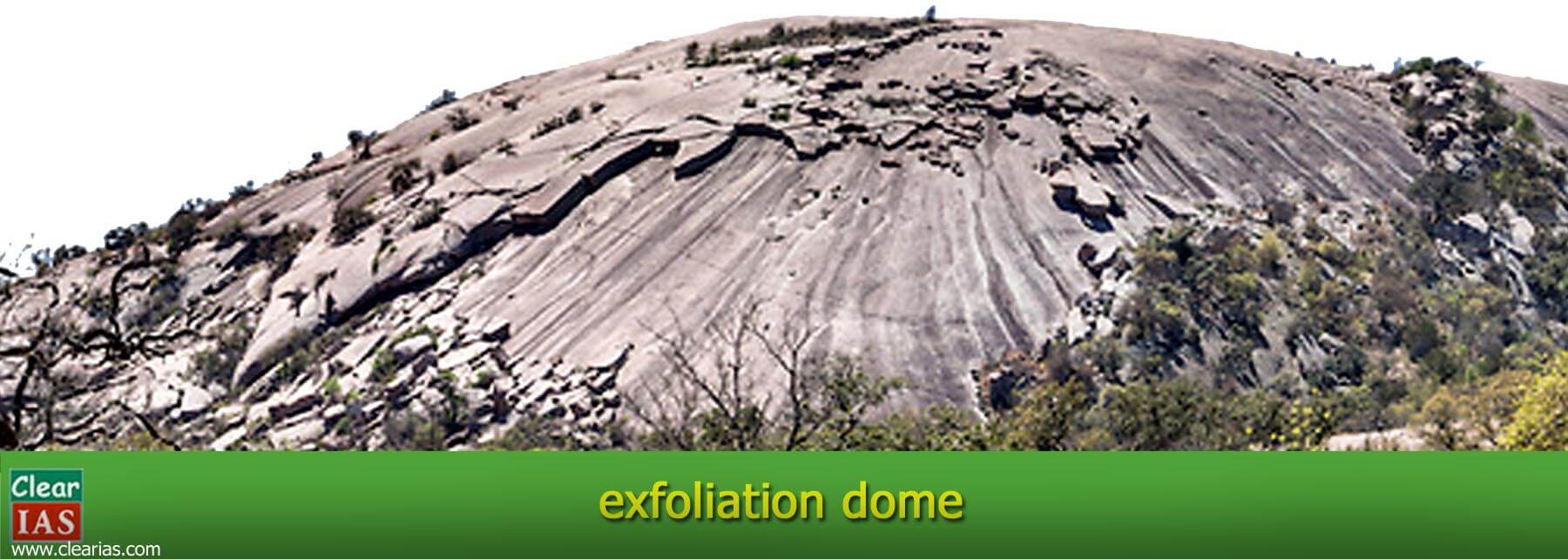
b) Temperature changes and expansion:
- With rising in temperature, every mineral expands and pushes against its neighbour and as the temperature falls, a corresponding contraction takes place.
- Due to differential heating and the resulting expansion and contraction of surface layers and their subsequent exfoliation from the surface results in smooth rounded surfaces in rocks.
- In rock like granites, smooth-surfaced and rounded small to big boulders called tors form due to such exfoliation.
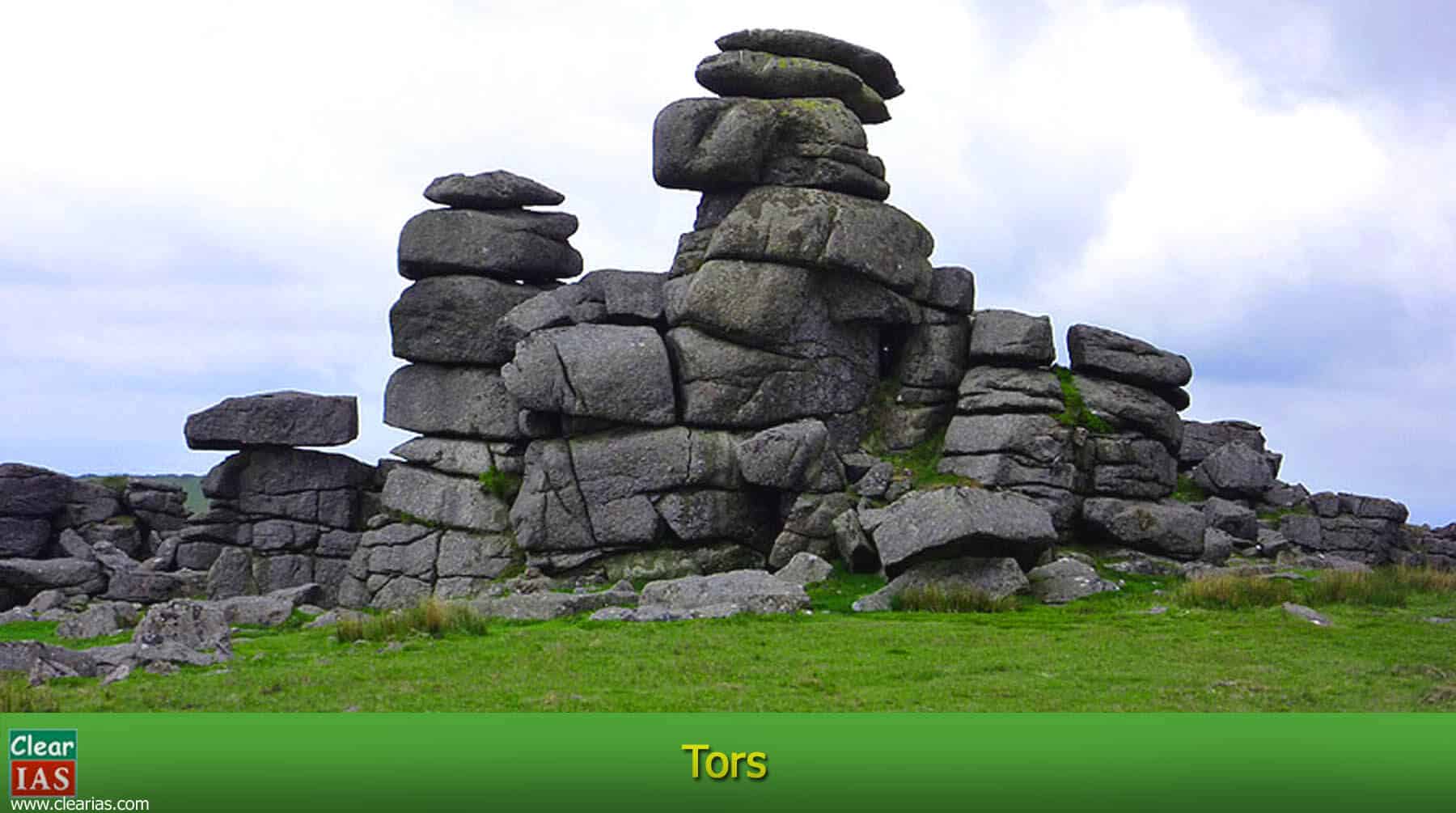
c) Freezing, Thawing and Frost wedging:
- Cycles of freezing and thawing (the weather becomes warmer and causes snow and ice to melt) cause frost weathering.
- It is most effective at high elevations in mid-latitude where freezing and melting is often repeated.
- Rapid freezing of water causes its sudden expansion and high pressure. The resulting expansion affects joints, cracks, and small intergranular fractures to become wider and wider till the rock breaks apart.
d) Salt weathering:
- Salts in rocks expand due to thermal action, hydration and crystallization.
- Many salts like calcium, sodium, magnesium, potassium and barium have a tendency to expand.
- The expansion depends on temperature and thermal properties. High temperature ranges between 30-50 0 C of surface temperatures in desert favours such salt expansions.
- Salt crystallization is the most effective of all salt weathering processes. It is favoured in areas of alternative wetting and drying conditions.
(2) Chemical weathering
Chemical weathering can be due to solution, carbonation, hydration or oxidation/reduction.
a) Solution:
- When something is dissolved in water or acids, the water or acid with dissolved content is called a solution.
- This process involves the removal of solids in solution and depends upon the solubility of a mineral in water or weak acids.
- When coming into contact with water, many solids disintegrate and mix up as a suspension in water.
- Soluble rock-forming minerals like nitrates, sulphates, potassium etc are affected by this process.
- This kind of weathering mainly occurs in a rainy
- Minerals like calcium carbonate and magnesium bicarbonate present in limestone are soluble in water containing carbonic acid (formed with the addition of carbon dioxide in water) and are carried away in the water as a solution.
- Common salt is also a rock-forming mineral and is susceptible to this process of solution.
b) Carbonation:
- Carbonation is the reaction of carbonate and bicarbonate with minerals and is a common process helping to break down feldspar and carbonate minerals.
- Carbon dioxide from the atmosphere and soil air is absorbed by water to form carbonic acid that acts as a weak acid.
- Calcium carbonates and magnesium carbonates are dissolved in carbonic acid and are removed in a solution without leaving any residue resulting in cave formation.
c) Hydration:
- Hydration is the chemical addition of water.
- Minerals take up water and expand; this expansion causes an increase in the volume of the material itself or rock.
- The process is reversible and long, continued repetition of this process causes fatigue in the rocks and may lead to their disintegration.
- g. calcium sulphate takes in water and turns to gypsum, which is more unstable than calcium sulphate.
d) Oxidation and reduction:
- In weathering, oxidation means a combination of a mineral with oxygen to form oxides or hydroxides.
- Minerals most commonly involved in this are iron, manganese, sulphur etc.
- The red colour of the iron upon oxidation turns to brown and yellow.
- In this process of oxidation, rock breakdown occurs due to the disturbance caused by the addition of oxygen.
- When oxidized minerals are placed in an environment where oxygen is absent, reduction takes place.
(3) Biological weathering
- This kind of weathering is caused by several biological activities like the growth or movements of organisms.
- They also bring conditions for physical or chemical weathering.
- Grazing of animals, ploughing by human beings etc. are examples of biological weathering.
Also read: Earth’s Crust: Elements, Minerals and Rocks
Mass Movements
These movements transfer the mass of rock debris down the slope under the direct influence of gravity.
Mass movements are very active over weathered slopes rather than over unweathered slopes.
Usual geographic agents like running water, glaciers, wind, waves etc do not have much role to play in mass movements, and it is gravity, which is the main driving force.
Mass movements are classified into slow movements and rapid movements.
(1) Slow movements:
a) Creep:
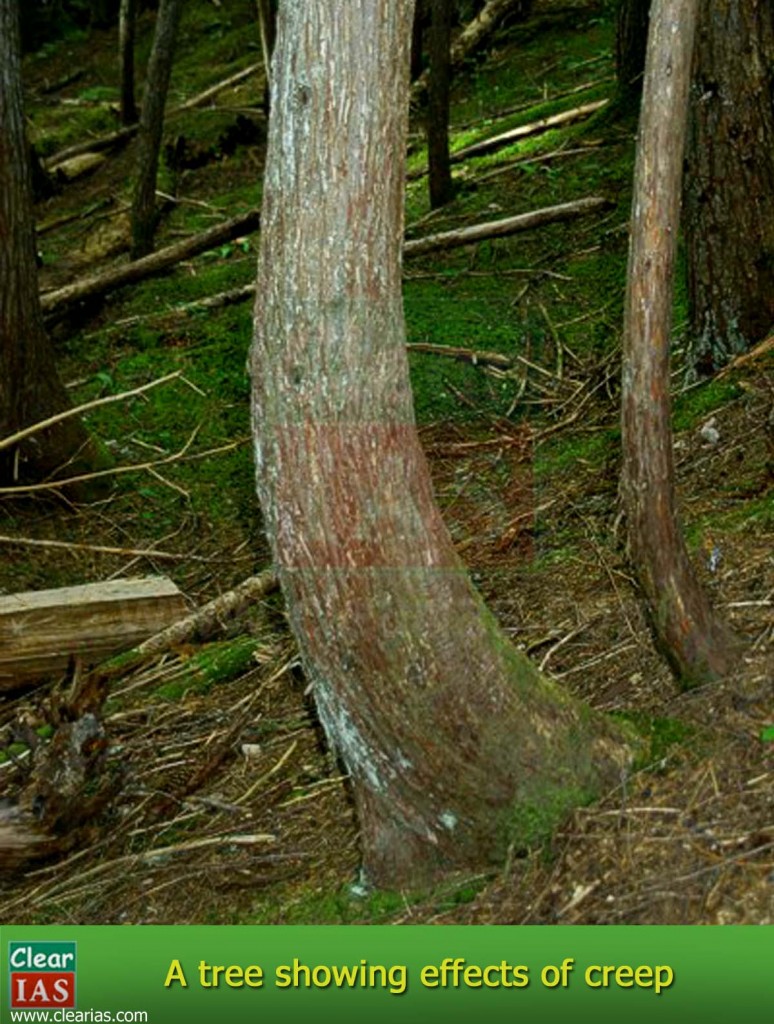
It occurs on moderately steep, soil-covered slopes (doesn’t need to be lubricated with water as in solifluction). The movement is extremely slow and imperceptible except through extended observation. We might notice that some of the electric posts in our region which are posted in sloppy areas deviated from their horizontal linearity. This is an effect of creep.
b) Solifluction:
It is the process of slow downslope flowing of soil mass or fine-grained rock debris saturated or lubricated with water. It can be said as a type of creep with lubricated water influences the movement. It mainly occurs in permafrost regions as the layers of groundwater are occupied in between permanently frozen soil and rocks.
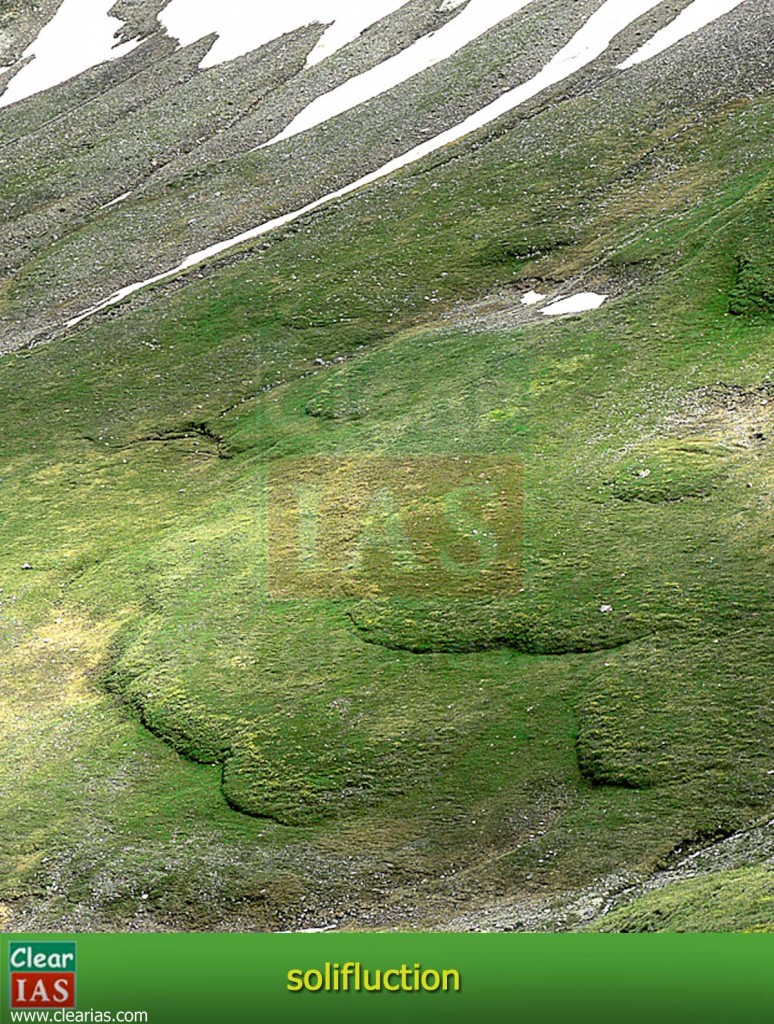
(2) Rapid movements

a) Earthflow:
The movement of water-saturated clayey or silty earth materials down low angle terraces or hillsides is called earthflow.
b) Mudflow:
In the absence of vegetation and cover and with heavy rainfall, thick layers of weathered materials get saturated with water and either slow or rapidly flow down along definite channels is called as a mudflow.
c) Debris avalanche:
It is more in humid regions with or without vegetation. It occurs in narrow tracks on steep slopes and is similar to snow avalanche.
d) Landslides:

In landslides, the materials involved are relatively dry irrespective of the above said rapid mass movements. Landslides can be classified into a slump, debris slide, rockslide etc
- Slump: It is a type of landslide in which the slipping of several units of rock debris occurs with a backward rotation with respect to the slope over which the movement takes place.
- Debris slide: In this type of landslide, there is no backward rotation. The fall is almost vertical.
- Rockslide: It is nothing but the slide of individual rock masses.
Erosion and Deposition
Erosion is the acquisition and transportation of rock debris by geomorphic agents like running water, the wind, waves etc.
Though weathering aids erosion, it is not a pre-condition for erosion to takes place. (i.e., erosion can take place in unweathered conditions also)
The deposition is a consequence of erosion. The erosional agents lose their velocity and energy on gentle slopes and materials carried by them start to settle themselves.
Note: Deposition is not the work of any agents. It is just the end result of erosion.
Next in the series: Erosion and Deposition: Action of Running Water and Groundwater
Article by: Jijo Sudarshan






Excellent piece of information
excellent work done by u sir. I grabbed a good essence from this article regarding the weathering phenomena….thanks a lot!!
An excellent task
Comprehendable work .i really enjoyed.
I enjoyed your presentation….. Its very clear….be blessed.
U are simple and awesome
Really, really good and I love and enjoy it the most thanks.
Thanks, it is also help to me🤗
Content is really very helpful and point to point…..no need to search for another sources….. proper explanation is provided…..well done….. thankyou so much
The notes are exiting.
Accept my heartiest regards for such a splendid work all the way from Pakistan.